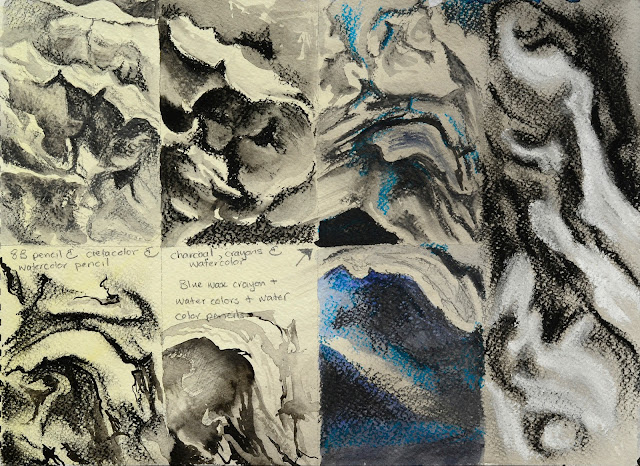As is my custom, I started my day by looking through The Weekender magazine published by WeAreOCA. I was really excited when I watched the video clip on the work of Georgina Emmett (Georgina Emmett, Painting 1 – Bryan Eccleshall , 2016). Here was a fellow student who was working with the negative shapes caused by the shadows of trees. I liked Bryan Eccleshall's comment that "the shadows cast by the objects are like objects themselves". (Georgina Emmett, Painting 1 – Bryan Eccleshall , 2016). What excites me is that she has managed to play with the stained glassed window effect of silhouetted trees against a deep vibrant background in a way which is rich a texturally invigorating. This gives me the courage to try to explore to a greater extent my own fascination with negative shape and the play between surface details and the intrinsic depth of the scene behind the foreground subject.
For this next sketchbook study, I laid down a dark brown and black ink wash with intermittent scratched areas. I also prepared a page with crayon rubbings and ink washes created by rubbing a crayon against an squashed aluminum drink can. This created a textural surface which replicates the rough texture of the bark I was drawing. I then stuck this down to the left-hand side of the sketchbook page.
I chose a section of a piece of bark. I tried to push the way I worked this study to become more layered than in my previous studies, and to push more towards abstraction. What I found hard about working on top of the affixed paper which had the rubbings was to be able to integrate this paper so that it blended in with the working of the rest of the watercolor paper. I also found that the paper buckled a bit which at times did not work in with the form of the images I was working into its surface.
 |
| Fig. 1 Bark Study - mixed media. |
Despite the fact that I tried hard to create a three dimensional effect with the modeling of form of the bark, my overall image seems a flatter than I had wanted. I held my picture from a distance and found that the forms were not totally convincing. My husband suggested that I needed to work on adjusting the lighting on the bark to emphasize the forms. I had thought that I had enough of a contrast from the lighting coming in from the window on the left, but as it is dark inside, I also had overhead lighting. I think this contributed to the feeling of flatness.
What I will need to work on is in getting an accurate sketch down first before working in areas. As I had not done this, my bark morphed as it went, which did cause areas of the study to lose its form and to distort beyond being able to understand its form.
As both of the previous studies were dark in overall form, I am going to try to do a study of the leaves of thistles concentrating on lightening my palette and also concentrating on working details into negative spaces.









